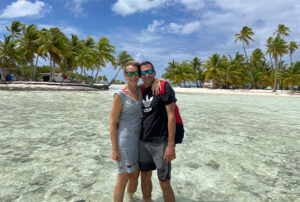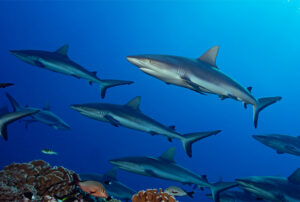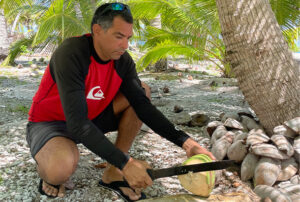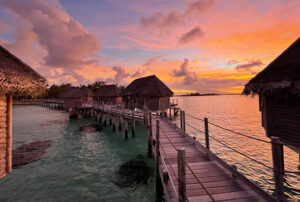I am 40 feet underwater, diving off the coast of Loreto in Baja California Sur, Mexico, when my husband falls from a ladder and suffers a traumatic brain injury at our home in Tampa, Florida, 2,500 miles away.
The scene below the surface is a dream—a drift dive along a volcanic wall waving with soft corals, where eels hang their gaping jaws from nooks and crannies and clouds of yellowtail snapper flutter past. At the end of the dive, I’m the first to reach the boat ladder, shivering in my wet suit, but I decide to linger on my safety stop to take in the waters that Jacques Cousteau called “the world’s aquarium.”
When I climb back onto the boat, the dream becomes a nightmare. A flurry of missed calls and text messages. Javier is in the ICU. I can’t breathe. Someone puts a towel over my shoulders, and a pod of dolphins that had evaded us underwater—we’d heard their vocalizations the entire dive but never saw them—suddenly encircles the boat as we speed away, as if escorting us back to the docks so I can hurry home.

You could say Javier and I had been treading water to stay at the surface since the start.
I met him in Negril, Jamaica, at a bar called Bourbon Beach—an oceanfront spot that skews seedier and sultrier as the night wears on. His pick-up line: “I have hot water and air-conditioning.” Maybe it was because I was 40 and open to exiting a long-term relationship that had been going nowhere for too long, but the line worked. Maybe I would even have a baby before it was too late. We fell in love like something I’d only seen on the big screen—ridiculously fast, hopelessly deep.
Two months later, I was pregnant with our son, and not long after that, Javier, who is Cuban, landed at the airport in Miami with a K-1 visa in hand, my 90-day-fiance in real life.
The five years that followed were a blur. One kid turned into two. And there were so many things to navigate within the powder keg of cultural differences and differing expectations (his: a hot lunch; mine: girls’ weekends—you can guess who won that one). Javier would tell me to iron his shirts and even gave me tips on breastfeeding, much to my irritation; on the other hand, he would cut my father’s hair and swab the wax from his ears when he came to visit, wondering why I didn’t take care of my own blood the way he did growing up. When I met him in Jamaica, he’d only ever been on one flight, the plane that carried him there from Cuba, and had never dated anyone who wasn’t Cuban. I’d spent my last 20 years traveling the world, first as a budget backpacker and then as a travel writer, and had lost track of how many countries I’d visited and foreign flings I’d had.
The ocean, though, was always a unifier. I’d been an avid diver since I took an open water course as an elective during my final year at the University of Florida, and I took every chance I got to be underwater. Javier was a natural freediver, plunging down to spear a lionfish for dinner or pluck a lobster from a crevice with his bare hands. When we first met, we’d snorkel in front of his apartment in Negril, my belly growing rounder with our son and eliminating the option of diving with a tank. When he would surface with excitement at the sight of dead coral heads and a fish or two (Jamaica’s reefs have largely been decimated by overfishing, boat damage, and other threats, although some are making a comeback), I told him he needed to learn how to dive and promised someday to take him to see the Pacific.
I dreamed of traveling with him to Tahiti, my favorite palm-fringed place in the world, and the Tuamotus—a largely uninhabited archipelago of 77 atolls and islets spread across 930 miles of Pacific Ocean, a one-hour flight from Papeete—where we could scuba dive and take in the best underwater views on Earth. Removed from the honeymooners and busy overwater bungalow scene of Bora Bora, the quieter atolls attract an intrepid crowd of divers and sailors (the latter living largely off the grid). Currents rush through coral-covered passes into lagoons rich with marine life at atolls like Rangiroa, Fakarava, and Tikehau, creating dive sites that are the stuff of legend.

I’ve donned scuba gear off every continent but Antarctica, including in the Bahamas, Egypt, and Norway. Javier, however, didn’t share my passion. Growing up in communist Cuba, scuba diving wasn’t anything he’d ever dreamed of trying. (Even fishing or sailing a Hobie Cat from a resort beach was pretty much forbidden by the regime.) Over the years, I tried to get him to learn, but he approached it with a similar enthusiasm to which I’d taken up watching America’s Got Talent for him. Just before his accident, he finally got certified—for me.
And now, on this flight home from Mexico, as I worry about him, I also can’t help but wonder if all of the dreams we have for our future will come true.
But Javier is a fighter. When I first see him in the ICU, his arms and feet are restrained, his neck in a brace, as the doctors wait to see how bad the damage is to his back and brain. His eyes flutter open when I ask if he knows who I am. “My wife,” he grumbles. “Why are my hands like this?” he asks me, over and over. “Why am I here?” The doctors call it perseveration and say it’s normal for someone in his condition. Despite his face remaining as handsome as ever, somehow unscathed, I barely recognize my husband. He remembers nothing from the day of the accident, and it takes a few days before he accepts that it happened at all (“OK, if you say so,” he says with a sigh, each time I remind him), and a few more before he can recall the year and who’s president. I am happy he’s alive but also worry he’ll never be the same. But prayers come in from every direction—even my atheist orientation—and I start to believe they might work. A nurse who saw him on day one almost faints when she’s back at the hospital after a few days off and sees him up and walking on day five. His recovery is nothing short of a miracle, everyone tells us, and after two weeks we go home.
It feels like another miracle, four months later, when he passes his U.S. citizenship exam, knocking it out of the ballpark by answering every question correctly (including the ones I get wrong when he tests me). He immediately applies for a U.S. passport, which we expedite. This is his ticket to travel the way I have always been able to, and I’ve never been more grateful for the privilege.
We know we have to celebrate this milestone and Javier’s recovery, and we don’t want to waste any time. His doctor has cleared him to drive—and to dive. So, just six months after his accident, we take off for 10 days in the Tuamotus.
Our first day of diving isn’t what I hoped for. On the outside of the pass that flows into Rangiroa, the world’s second-largest atoll, which circles 110 miles around a pristine lagoon, we deflate our buoyancy control devices to descend into the water and start our first Pacific dive together. Only, Javier isn’t going down.

Barely below the surface, his eyes are wide in his mask—and not at the sight of the dolphin and its day-old nursing calf that finned under us in a flash. Our dive guide gives him the “OK?” hand gesture to see if he’s fine, but he just shakes his head, rubbing both sides of his jaw, as if trying to coax a genie from his brain. He stares longingly at the surface.
We pop up, and Javier pulls the regulator out of his mouth and swims back to the boat. He doesn’t want to go down. Something about the vertigo he felt when he went underwater reminds him of his fall from the ladder, he says—even though he can’t remember that moment at all. I continue on my own with the guide, bummed I can’t share everything there is to see in this place we’ve traveled so far to dive.
For all the differences we have on land, the ocean is a world I want so badly to be both of ours, in a way that topside culture so far hasn’t. But I don’t want to push him. With a dive guide as my fill-in buddy, I drop into the depths and sometimes peer up to see Javier kicking in the shallows, the gin-like clarity of the water making the distance between us seem even greater.
Somehow, though, in the days that follow, as our experiences underwater diverge, we find ourselves bonding back at the surface. On a dive in the Tikehau lagoon pass, I see a great hammerhead come careening over the reef, dispersing scores of gray reef sharks like bits of lead fleeing a magnet. I surface, itching to tell Javier, who is bubbling with his own post-snorkel excitement about the first Napoleon wrasse he’s seen (huge Indo-Pacific fish, they look like they’ve been tattooed by the gods) and the sea turtles swimming in the shallows that I missed.
On Rangiroa, we rent a motorbike where we’re staying, the sweet little Hotel Maitai, busy with Spanish divers, and Javier asks the man behind the desk to borrow a machete. “You’re the first tourist I’ve ever seen cut down coconuts,” the impressed clerk tells him later. I’m reminded of the many skills Javier picked up during his island upbringing: I might have shown him how to pump gas when he first arrived in the U.S. (he didn’t own a car in Jamaica), and how to write a check, but he taught me that sea grapes are edible (and the perfect mix of salty and sweet) and how to make orchids rebloom on repeat inside a coconut husk.

From our overwater bungalow on a private motu in Tikehau, we sip our morning coffee and watch a curious triggerfish that stares up at us from the shallows for three mornings straight. Strolling the pier at Fakarava atoll’s Havaiki Lodge one afternoon, we’re captivated by patrolling nurse sharks corralling mullets.
Being together in a tropical place, where neither of our cultures dominates, somehow emphasizes the common ground between us. It’s just what we need. Our relationship has always been an awkward dance, jockeying the cultural divides—more improv than smooth salsa rhythms.
But if our love has any common language, I realize it has been the ocean’s all along.
On our last day on the water in Fakarava, we head out with Thibault Gachon of O2 Fakarava dive shop. Javier lets Gachon know he had problems descending and would prefer just to snorkel instead. I’m used to this routine by now, and I hide my disappointment, even though Fakarava’s north and south atoll passes, Garuae and Tumakohua, are my favorite of all. At the latter, you enter the water outside the pass and drop immediately into a wall of patrolling reef sharks that darkens the 80-foot-deep water column, then ride the current past clouds of jewel-toned anthias and other tropical fish crowding the shallow corals of the lagoon. Sometimes, mantas wing by. It’s pure ocean wonder, abundant and accessible in a way that’s matched by few places on the planet.
As we approach the dive site, though, I can see that Javier is calmer than he has been before any other dive on this trip. Gachon convinces him to try to go down one more time—winning an argument no wife could—and as he slowly guides Javier down from the surface, I look up from below: My husband is, of course, a natural, with the buoyancy control of a far more experienced diver. After all, he has been adapting and surviving since the day he was born.
As we fin next to each other, he grabs my arm to show me pyramid butterflyfish and Picasso triggerfish—typical Pacific denizens that capture his eye because they’re so different from their Caribbean cousins. I point out Christmas tree worms and other oddities I’ve learned to spot after many years of diving.
Gachon directs us to kneel under a ledge, sheltered from the current. The stiller we stay there, the closer the curious sharks come. Our wide-eyed gazes switch between each other and the animals.
Even if we could speak, there is no need. Some might say you shouldn’t have to travel thousands of miles to remember the things you’ve always seen eye to eye on. But sharing this world below the water helps remind us of all we have in common back at the surface, too.
Next Up: Diving Deep with Korea’s Sea Women
